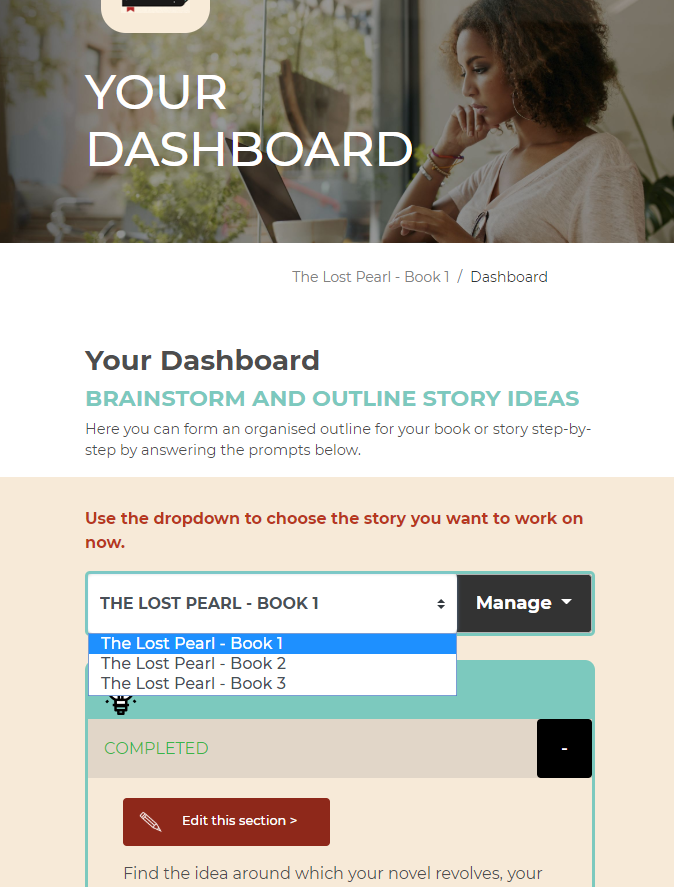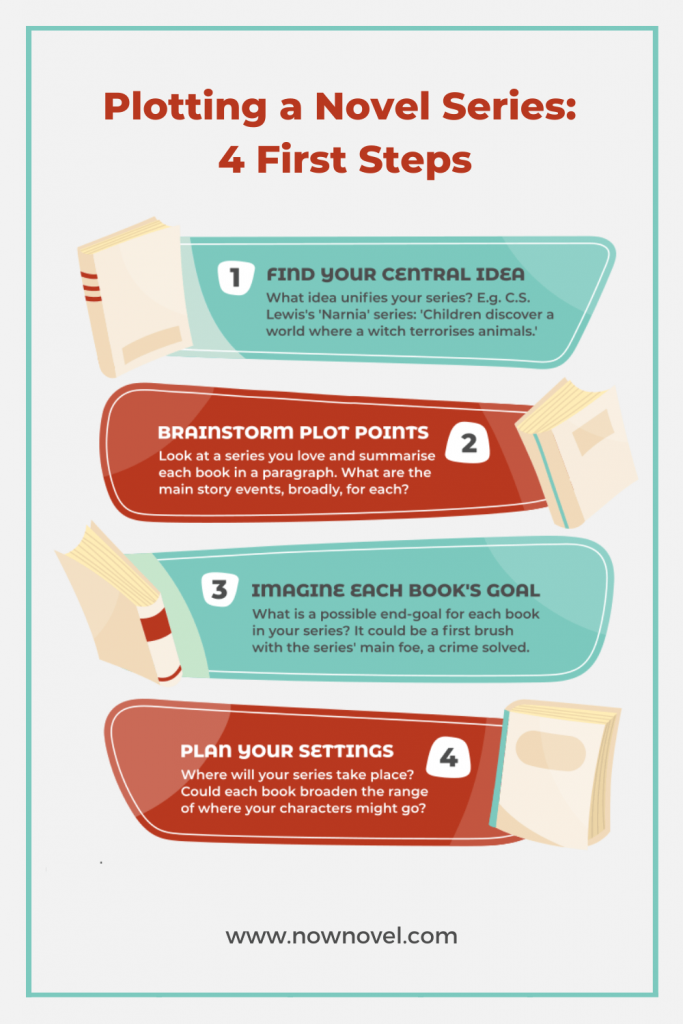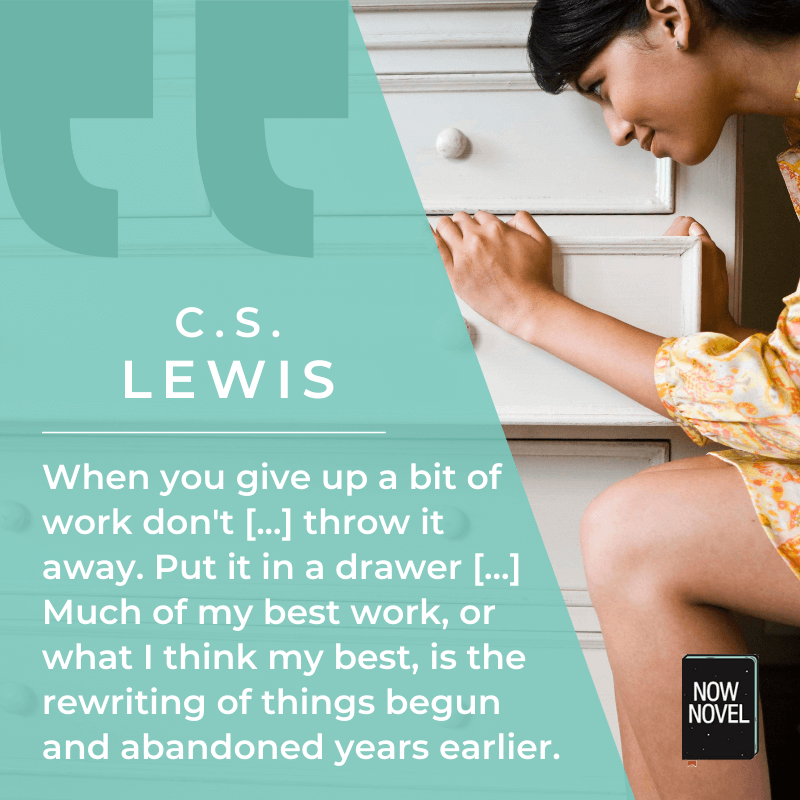Plotting just one novel is challenging, never mind plotting a multi-book arc. Having structure and a plan helps. Here’s how to plot a series in 8 structured steps.
Let’s first briefly define what a series is. They can be a set of stories broken down in to a few stories, or books, such as the Harry Potter books, following a main group of characters, again, as with the Potter books. The characters will change through the series. Another example is that of The Hunger Games. There’s a static series, where a character reoccurs, but doesn’t change in any major way, such as Agatha Christie’s Hercules Poirot’s murder mysteries Other examples are Nancy Drew and Sherlock Holmes.
An anthology series is an interrelated novel that shares a setting, such as The Chronicles of Narnia. An anthology series doesn’t necessarily feature the same character or group.
How to plot a book series: 8 steps
- Find your Central Idea, decide what type of series you are going to write. Decide if it will it be an episodic series with one central story over many volumes (i.e. every story is self-contained).
- Brainstorm key plot points for each book
- List ideas for each book’s end goal and the series
- Decide on the broad setting of your series
- Study successful series’ plot structure for insights, plot your story arc
- Brainstorm characters who will carry your series, plot your character arcs
- Outline your series’ main events and themes
- Start and strengthen arcs between books later
Let’s explore each of these steps deeper:
1. Find your Central Idea
Every great series grew from the kernel of an idea.
J.K. Rowling, for example, famously said that the idea for her wildly successful Harry Potter series formed while stuck on a delayed train between Manchester and King’s Cross, London in 1990. She plotted the 7 books of the series over the next 5 years.
Examples of series’ central ideas
You might summarize Rowling’s central idea thus:
‘A seemingly ordinary boy, Harry Potter, orphaned and raised by his mean aunt and uncle, discovers he has magical abilities and is invited to attend a school for wizards. As a student and increasingly able wizard he forms deep friendships (and enmities), and must eventually face his parents’ killer.’
This central idea has plenty of room for expansion across multiple books.
It has room for:
- backstory about how Harry was orphaned
- the adventures, magical discoveries, friends and foes he finds at his magical school
- the overarching, looming confrontation with his parents’ killer
- secondary conflict with his aunt and uncle.
To take another example of a series idea, C.S. Lewis’ Chronicles of Narnia series from the 1950s could be summarised thus:
‘A mythical lion builds alternate worlds that earth-born children accidentally discover. Yet through their discovery, they also introduce evil but with the help of the lion Aslan, subsequent generations safeguard Narnia from malevolent forces that wreak destruction in their quest for power.’
Both these famous examples of fantasy series have central ideas that leave whole worlds to be discovered.
Brainstorm and tweak an intriguing central idea for each book in your series using the first step in Now Novel’s story planning dashboard.

2. Find key plot points for each book in your series
When you’re still learning how to plot a series it’s easy to get lost in details. It’s hard to see the big picture when there isn’t one – yet. That’s why it’s a good idea to draft and sketch an outline of key plot points for each book.
nsider what the overarching plot is as well, if there is one. Will these be separate books with a linked character i.e. Hercules Poirot in the Agatha Christie mysteries, or a large story broken into several books as in the Harry Potter books? Decide what types of series you will be writing. You might have a cast of characters that feature in each book, such as in the Harry Potter ones.
A tip here: even if you are intending to write a whole series, treat each novel as a standalone book, rather than possibly becoming daunted by the idea of writing a seven-volume series, for instance.
For example, here’s a summary of key plot events [spoilers alert] in the first four novels of C.S. Lewis’s Chronicles of Narnia series [in Harper Collins’ chronological reading order, not the original publishing order, since The Magician’s Nephew was a prequel published five years after the first book]:
Breaking down plot points in a series – Narnia
Book 1 – The Magician’s Nephew (1955)
First encounter with the world of Narnia. Children Polly and Diggory (who is grown up and hosting the child protagonists in Book 2) are transported to another world. This happens when Digory’s uncle tricks Polly into trying on a magical ring that allows one-way teleportation, forcing Digory to go after her.
The children end up in a magical wood containing pools that are portals to other worlds. Entering one of the pools leads to an encounter with a witch queen, Jadis.
Jadis killed every living creature in her world in battle by speaking ‘the Deplorable Word’. She follows them back into another pool, where they encounter Aslan, a mythical lion, who sings the land of Narnia into being. Jadis attacks Aslan and flees into his world, and Aslan tasks Digory with protecting the world from Jadis for having brought her there.
Book 2 – The Lion, the Witch and the Wardrobe (1950)
The four Pevensie siblings are evacuated to the countryside at the outbreak of World War II. They stay in now-older Digory Kirke’s house and discover a portal to another world at the back of a wardrobe while playing hide and seek. Here they encounter the White Witch aka Jadis, who holds the world in eternal winter. Eventually, they undo her enchantment and become kings and queens of Narnia, starting a Golden Age.
Book 3 – The Horse and His Boy (1954)
During the Pevensie siblings’ reign over Narnia, a boy named Shasta is sold as a slave in the land of Calormen. In a stable he encounter a talking horse that was captured from Narnia named Bree, and together they plan their escape to Narnia and freedom. They meet another pair of escapees, Aravis, a local woman who is fleeing an arranged marriage and her talking horse and travel together.
Book 4 – Prince Caspian: The Return to Narnia (1951)
The story takes place during the Pevensie siblings’ second trip to the mythical land of Narnia.
They return because Prince Caspian blows a horn left behind by one of the siblings, Susan, a horn enchanted to summon help in an hour of need. While they have been on earth, in their mortal world, 1,300 years have passed in Narnia, and their former castle lies in ruins (time passes faster in Narnia). Caspian has fled into Narnia’s woods to escape his uncle, Miraz, who has usurped the throne, and the children help him save Narnia from tyrannical rule.
Lessons from Lewis’ series
The key plot points from the first four novels in Lewis’ series show some important facts about writing a series:
- There is continuity between the series’ plot points. Lewis weaves the events of individual books into each other, creating history and folklore for his fictional world. Characters age and their roles and tasks alter (Digory, for example, develops from being a courageous young protagonist to being a secondary part, the avuncular host to the child protagonists of Book 2).
- There are key themes that echo across the books. Themes such as courage vs fear, creation vs destruction, the need to restore justice and order when malevolent individuals gain power.
- The world builds from the start. First, in The Magician’s Nephew, it is a new world. Then it becomes a winter vault under Jadis’ rule and then we see (in The Horse and his Boy) its multiple peoples and cultures. It develops its own horrors (a slave trade, kidnap marriages) and wonders (talking horses and other magic). Brainstorm details of culture and history and invent worlds and countries for your story in Now Novel’s World Builder.
Plan how individual books’ plot lines will ripple out through your series. Now Novel’s scene builder is a creative, corkboard-like tool for starting this process.
Think how each book can add extra detail, conflicts and resolutions to prior events.
Plan your series in detail
Outline book ideas in easy steps with a story summary that grows with your ideas.
Upgrade to toggle between books.
3. List ideas for your series’ end goal
Each book will ideally reach a smaller goal within your series broader arc. Yet unfinished business keeps readers coming back for more. A series writer has to polish and finesse each book and story, so that readers are never left disappointed.
For example, by the end of Harry Potter and the Philosopher’s Stone (UK title), the first book in Rowling’s series, Harry has had his first major confrontation with the arch villain, Lord Voldemort.
In the first novel of James Patterson’s ‘Alex Cross’ series, the protagonist’s final encounter with the antagonist implies future peril. The killer bribes a prison guard to leave a message threatening Cross and his family on the protagonist’s car’s windshield.
Each book in a series might bring confrontations (or, in the case of romance, romantic union) to a head. Yet there will also be lingering questions sequels can answer.
In learning how to plot a series, brainstorm what minor conclusion each book might come to early. This way, you can build in a sense of momentum and direction to a key event right from the start. You don’t have to stick with your first idea, but it’s a start.
Introducing questions and unknowns about your characters’ future (and what readers think they know about your world) will leave readers hungry to follow more of your series.
If you can already see this far ahead, list ideas for your series’ end-goal. In Harry Potter, it’s the final Voldemort vs Harry showdown. In Narnia, it’s the restoration of good leadership and freedom in the Kingdom of Narnia. Make the end-goal of your series one that is sure to involve conflict, obstacles, journeys and discoveries in the build-up.
4: Decide on the broad setting of your series
The entire arc of your series could take place in the space of 24-hours (like the TV series 24), with each book showing a different character’s overlapping experience of these 24 hours.
Or else, you could do like C.S. Lewis and have parallel worlds where time passes at different rates.
Whatever you choose, plan the setting of each book loosely [you can use the ‘Core Setting’ section in the Now Novel dashboard for this].
There will be necessary differences between settings far apart in place and time.
If, for example, the first book of your series is set in a realistic 1950 and the second in a realistic 2019, there will be major differences (no internet vs fibre internet, modern medicine vs older cures, and so forth).
Understanding the ‘scope’ of your series’ setting helps because:
- You will have a clear list of places and time periods you can research (if writing realist fiction) or brainstorm (for fantasy)
- You can think about the important ways time and place in your series will change within each book and between books
5: Study successful series’ plot structure for insights
To gain valuable series plotting insights, create your own summaries of your favourite series’ plot structure. Or find summaries online.
Jot down, in note form, the core events of each book. Ask yourself questions, such as:
- If I look at the series as a whole, what is the related purpose of this book? (e.g. for The Magician’s Nephew: Introducing the world of Narnia and how and why evil (Jadis the witch) was accidentally introduced to it
- Who are the main characters in each book, do they appear as central characters or in cameos elsewhere in the series?
- How do the themes of this book relate to others in the series?
Think of additional questions to ask. Creating or reading series summaries will show how your favourite authors weave their books’ threads together.
6: Brainstorm characters who will carry your series
In learning how to plot a series, it also helps to use a character-centric approach. Characters, after all, are the lifeblood of your story.
According to sci-fi author L. Sprague Camp (who wrote over 100 novels), planning series avoids inconsistencies. This is not to say there can’t be earned change, though.
If we look at C.S. Lewis’ children’s fantasy series, central characters’ roles shift. They go from protagonists to minor, supporting characters. The one main character who appears in all seven books is the lion/creator, Aslan.
Take Harry Potter as an example. We can imagine having Harry as a starting character before sketching out the story. You could start by working out what roles Harry and other characters play.
Characters’ relations to Harry include:
- Helpful, steadfast friends with interesting, contrasting (often conflicting) personalities. Laid back, slightly lazy Ron and energetic, academic star Hermione
- Characters who give Harry the psychological wounds that inform his struggles. His bullying aunt and uncle, or the main villain
- Enemies. Voldemort’s supporters, sadistic teachers, envious school bullies (Draco and his goons)
- Neutral or helper characters who are also detailed. The owner of the wand shop, for example, or the minor characters who fill Hogwarts’ halls (students such as Lavender Brown and Parvati Patil)
When you brainstorm characters while plotting your series, think about what function they will serve. Will they help or hinder main characters? Or are they neutral characters who serve smaller, once-off story functions?
Writing coach Romy Sommer shares more tips on getting started writing series and worldbuilding in this brief extract from our full webinar on series and serials:
7. Outline your series’ main events and themes
This is a process you ideally complete before you start drafting. If you have pantsed your way through the first book or two, it’s also a productive process when revising. A story outline will help you see where the plot gets thin or forced.
Try to write a one-page synopsis for each book [use the ‘Summary’ section of the Now Novel dashboard to expand each book’s main idea into a page-long summary]. What are its core events, conflicts, character goals and plot twists? Print and lay these synopses out side by side. Are there any holes? Is there enough cohesion across the entire breadth of your series?
Once you know themes your budding series already tackles, outline ways you could develop them in the next books.
When you plot a sequel, think about lines of continuity. How you can extend and develop your characters’ backstory and ongoing development?
8: Start and strengthen arcs between books later
If you want to write a multi-novel arc, don’t agonize over the sequence of things. As we see with C.S. Lewis, you could start at any point and later write a prequel. Tolkien didn’t intend The Lord of the Rings as a series but as a single volume. You can work out the connective tissue between books when you are further along in the drafting process, too.
Whatever method you choose, make sure each book in your entire series is enjoyable alone, as well as when it is taken as part of a larger whole. To do this, give it narrative suspense, great characters, varied settings and plot points and all the other ingredients of a great story.
Use a simple, structured tool to outline each book in your series in depth to make swifter progress in creating stunning sequels and prequels.




23 replies on “How to plot a series: 8 steps for multi-book arcs”
I would love to write a Science Fiction series!
so write it!
You can do it 🙂
I’m writing a novel and was thinking of writing a series. This page helped me a lot. Thanks 🙂
Glad to hear it, bookworm!
I have a question about the overall main plot of a series. Would an individual arc feel incomplete if say there is a prophecy mentioned that ties into the individual plot of the story?
I wanted to write a series that had the overall main plot about a prophecy but I fear this may make each book seem incomplete.
I loved the Cirque du Freak series because the main character is not loved by everyone, and there are so many surprises, but at the same time everything adds up the more you read. I want to write a science fiction series but I do not know where to start or how. So far I have been reading advice articles but I have found nothing.
This is one of my favorite blogs. I’ve pinned a TON of great content from here. So I’ve nominated you for the Blogger Recognition Award.
Here’s the info on my blog>>> http://wp.me/p6PVez-1jg
Hi Tabatha, thank you very much!
This is a great blog. Strengthen in step 8 is misspelled. Not trying to be jerk.
Thanks, Psylencer, and great catch – we’ve corrected the typo. Thanks for reading!
Hey the info is good bit how can I believe that these great authors used it!! Have u written any books?? How can I believe you, whats your credibility??
Hi Nabhanyu! Thank you for reading and engaging with the ideas. Our in-house contributors all have tertiary (university) qualifications in literature and either are published authors or have professional experience as book editors and writing coaches. Skepticism is healthy! I’d suggest to pick and choose what advice helps you and ignore any that doesn’t 🙂
Great construction–sound foundations make for strong stories. Thanks for sharing.
Thanks, Elias!
Hey! I’m thinking of writing a series. However, it’s not like a gripping thriller or an intriguing sci-fi. It just traverses the life journey of a gay kid, starting from high school days to eventually settling down in life, over a span of 3-4 books. The genre is mainly romance, drama and social issues. Does it sound like something that would interest someone to invest their time in reading it?
Hey Jai! I hope your series is off to a good start already. I think it would definitely interest people who enjoy coming-of-age stories and LGBTQI+ stories. Armistead Maupin’s ‘Tales of the City’ series did something similar to that. Every book doesn’t have to be a nail-biting thriller! Great characters can carry a story where there isn’t relentless action or drama. Good luck 🙂
I am writing a series of fantasy novels, and find it important to pace the conflict and character growth to help leave room for further growth but, at the same time, have a conclusion.
I particularly love your tip for finding key points and clarifying my central idea.
Thanks for sharing!
Hi Jaya, thank you for reading our blog and sharing your own process and thoughts. I’m glad you enjoyed this article. Good luck with your fantasy series!
Marissa, I hope you began and finished the science fiction book you said you wanted to write. You don’t have to wait to find the great advice you seek to get started.
Agreed, Todd! Great point.
I’m a slow reader, but I usually get through seventy or eighty books a year, most fiction. I don’t read in order to study the craft; I read because I like to read
Hi Gerald, thank you for sharing that. That is an impressive count. What’s been your favorite book so far this year? I would say reading that much one acquires a sense for craft regardless (although I find giving feedback to other writers particularly helpful, as it helps one think how to solve story issues and challenges). Thanks for reading our blog.